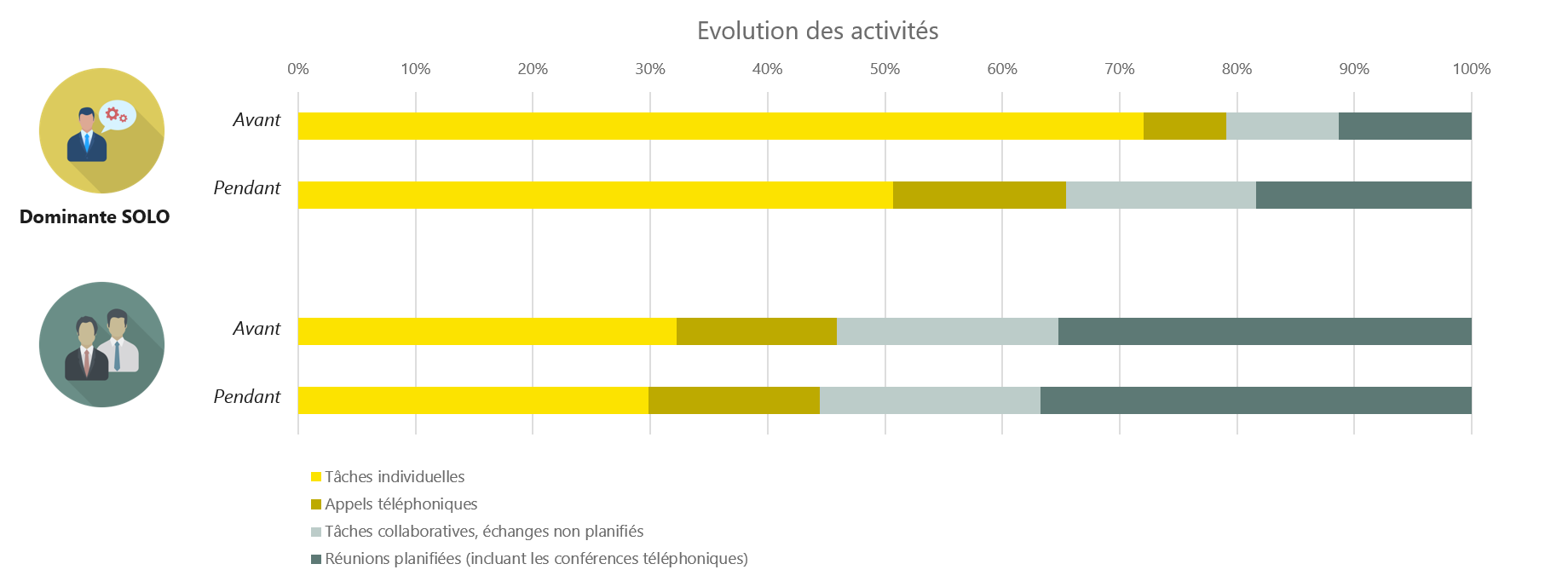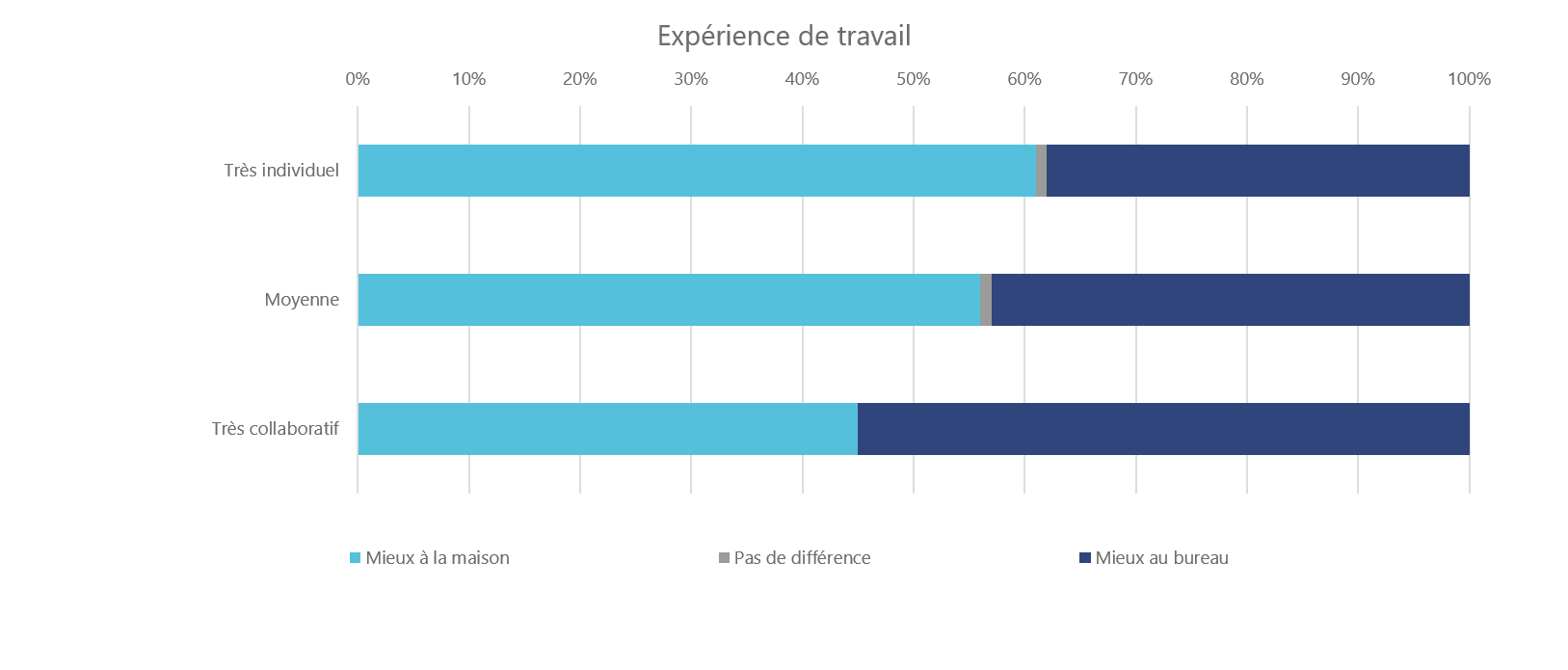- Home
- EN
- Our impact
- ProspeKtive
- Remote work and informal exchanges

Remote work and informal exchanges
April 2021
Expert
Each profession has its fads. For the work environment, there is collaboration, transversality and informal exchanges. They are very difficult to qualify. Time spent working together can be measured by time spent working in a group. This is easily identifiable because it is often planned. Transversality is assessed by studying the interactions between individuals and / or teams. But the informal? How to measure and qualify what is not observed with usual forms? What doesn't fit into the well-defined categories?
The actors themselves have a certain difficulty in describing the informal. Its existence is certainly recognized, especially by a few situations shared by many such as solving a problem by passing someone by chance at the cafe or at the photocopier or exchanging information within a team. But the spatial translation, often open spaces of exchange dispersed along the flow of traffic, leaves us wary. If these non-standardized tasks exist, how is the connection made with a sofa placed next to the workstations?
The health crisis has suddenly changed the daily working life of many service workers. The routines and habits of the office have been replaced by those of working from home. The functions have not changed (an accountant still keeps the accounts), but the way in which they are performed has changed. The analysis of the activities, carried out here by questionnaire, makes it possible to measure this evolution:

Graph A shows that, on average, the declared time spent in individual work has decreased by around ten points in favor of time in interaction, planned or not. The data collected in interviews point in the same direction. Many people feel they have never spent so much time in a meeting (on Zoom, Teams or others).
An initial analysis of the interviews suggested that this change in working methods concerned more particularly employees working alone. Those who had the most collaborative roles seemed to have transposed their movement from meeting room to meeting room in link-to-link navigation.

Graph B compares the working methods of employees working the most individually to those working the most in collaboration. He confirms that the evolution of working methods concerns more particularly the former, who report about a third less individual work. This reduction is made in favor of the time spent on the phone (which is doubling) and unplanned discussion and meeting times which each increase by around 65%. In all, for these employees, the total time spent interacting increases by 20 points (the equivalent of one day per week). At the same time, the most collaborative profiles declare relatively similar working methods before and after and forced teleworking. The qualitative data are therefore confirmed: teleworking has changed the activities of some tertiary workers and not all.
In an initial study conducted by Kardham during lockdown, 52% of respondents said they spent more time exchanging information and 42% spent more time in meetings. The results also indicated that the operational links within the teams had worked, unlike the transversality which had suffered. Of the two informal examples cited, it is therefore likely that this change in the time spent exchanging information and in meetings compensates for the exchanges that took place within the operational teams and not the exchanges at the coffee machine. And that those who said they spend more time exchanging information are the least collaborative profiles.
Does informal work for employees with the most individual tasks represent one working day per week? Difficult to say. However, experiences back in the office underscore its importance and the fact that it can take time. In recent months, those who have returned to the site sporadically have generally made the following assessment at the end of their day: "I feel like I haven't done anything." Talking with them, we realize that their day was filled with so-called informal exchanges, hence the impression of having done nothing, because these activities are not standardized. These exchanges took place almost everywhere in the company: around the coffee machine, in the corridors, in the meeting rooms, at the workstations. A little more rarely in the sofas which are placed in their extension. They had two objectives: to recreate group cohesion and to discuss the work in progress (to synchronize, exchange good practices or share a problem and find a solution). The most independent profiles interviewed (researchers, engineers, etc.) did not feel the same as those who were less independent; they have suffered less from work and want a more episodic return. Another interesting observation: those who came back once a week (or a little more) had this feeling of "lost day" the first times. Then, the activities at the office resumed a more normal course and they had it less. Once again, the quantitative data confirms this feeling: those who partially come to the office have a better evaluation of their exchanges of around 10%, whether within or between teams.
When you ask the most collaborative profiles about their return to the office, they will tell you that it is "nicer to see each other in real life, it is not the same thing". They will complain about meetings that have started to be late again (unlike virtual meetings) and the difficulty of having hybrid meetings (half-face, half-distance). Overall, they have the impression of being as effective in the office as they are when working from home (with nuances according to profiles and roles). A study by Leesman illustrates this result: while 61% of individual employee profiles believe they have a better work experience at home, 55% of the most collaborators have a better experience in the office.
Given that the professions did not radially transform overnight with confinement, it is possible to hypothesize that, for the most individual profiles, the informal sector would occupy a significant part of their working time ( about 20%, or one day a week). It would be linked as much to exchanges within operational as well as cross-functional teams. The informal is part of routines that require reinstatement when they have been broken. The data from the activities does not allow us to clearly define what the informal is for the most collaborative profiles. The testimonies show that these profiles were less unsociable with the remote work imposed. Some tell how they found alternative solutions to continue to "do meetings in the meeting" and / or "redo the meeting after the meeting" thanks to Teams conversations in parallel, private WhatshApp groups, debriefing calls, etc. . In addition, these highly integrated employees had more contact with people who were different because of their functions.
Therefore, not all employees have the same needs when they return to the office. The conclusions drawn about informal exchanges are not unlike those of Franck Duffy in the 1990s. The latter establishes different profiles according to the degree of autonomy and the need for interaction. For less autonomous profiles, marked by processes (administrative profiles) or by particularly intricate tasks (example: design office), he recommends environments in shared space. For the most autonomous workers who need interactions, such as project managers, he recommends an activity-based environment. For those who are independent and work more alone, he recommends closed individual spaces.
So those who have a more individual job will need a space in which they can meet with their peers. The interactions will take place in this multi-use place: it will be both a place of production, a place of socialization, a place of exchange, etc. With teleworking, this place can suit both very autonomous profiles as well as very intricate profiles. Various surveys have shown that returning to the office will be done primarily to work together. What will change is the frequency of visits to the office. The most autonomous profiles (whose archetype is the researcher) will come to the office to compare their ideas (brainstorming, exchange on content). But they will stay at home to develop them, polish them (readings, etc.) and put them in shape (writing articles, etc.). His arrival will be more episodic and longer than the less autonomous profiles (weeks per month for some against days per week for others, for example). As for the more collaborative profiles, they will benefit more from diversified work environments of the activity-based-working type. Studies had already shown, before confinement, that this work environment was the most suitable for their activities. For them, the return to the office will be more contextual and less predictable (depending on their agendas and that of their internal and external contacts).
A work environment (excluding common areas) adapted to hybridization (remote work and in the office) is emerging. First of all, it would be made up of co-location spaces, intended to be a place for informal exchanges and more particularly intended for interdependent workers coming together to spend time together. Then, various individual and group workspaces intended for the most collaborative so that they can go about their different occupations. That said, it remains to integrate personal preferences, certain business specificities and teleworking hypotheses, to correctly size these spaces intended for all those who have "a good reason to come to the office".
For further
- Kardham, Révolution OU évolution ? Permanences et mutations des environnements de travail après 2020, 2020
- Leesman, The rise and rise of Activity Based Working, 2017
- Leesman, Your workplace of the future, 2020
- L. Engelen, J.Chau, S. Young, M. Mackey, D. Jeyapalan
- A. Bauman. Is activity-based working impacting health
Release date: April 2021



